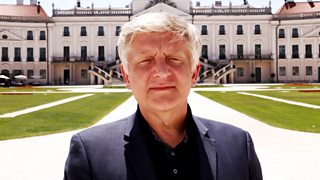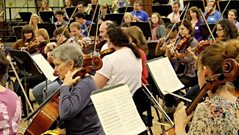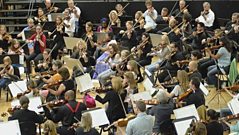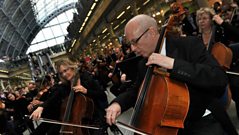
Dvorak - Symphony No. 9 in E minor (From the New World)
Donald Runnicles conducts the ����ý Scottish Symphony Orchestra in Dvorak' Symphony No. 9 in E minor.
Donald Runnicles conducts the ����ý Scottish Symphony Orchestra in Dvorak's Symphony No. 9 in E minor (From the New World). Recorded at the Usher Hall, Edinburgh.
“This new simplicity of outline may in part have resulted from Dvorák’s work in the New World as a teacher – after all, he had come to New York as the Director of the National Conservatory of Music, to high hopes within cultured circles that he would found a new American school of composition.”
ANTONÍN DVORÁK (1841–1904)
Symphony No. 9 in E minor, Op. 95 ‘From the New World (1893)
1 Adagio – Allegro molto
2 Largo
3 Scherzo: Molto vivace
4 Allegro con fuoco
It would be hard to exaggerate the impact of America on Dvorák. Although he travelled frequently in Europe, these relatively brief exposures to foreign culture did little to prepare him for the pace of life in New York. Dvorák was both fascinated and faintly appalled at the rich variety about him, ranging from judging an opera competition to a visit to Buffalo Bill’s Wild West Show. He arrived in New York at the end of September 1892, just in time to experience the 400th-anniversary celebrations of Columbus’s ‘discovery’ of the New World. While the crowds and marching bands had a more palpable effect on portions of the cantata, The American Flag, which he completed early in the new year, the welter of impressions delivered in rapid succession in this bracing city doubtless had a profound effect on the new symphony.
Dvorák worked on his symphony ‘From the New World’ between January and May 1893. The premiere was given at Carnegie Hall on 16 December the same year, to huge public acclaim, by the orchestra of the New York Philharmonic Society under the baton of Anton Seidl. Curiously enough, although the symphony has enormous popular appeal, critics rarely give it the unqualified approval accorded his Seventh Symphony. In style, the ‘New World’ Symphony differs considerably from Dvorák’s earlier works in the genre, avoiding the pervasive seriousness and dense technical argument of the Seventh, but also steering clear of the free-wheeling formal experiment of the Eighth. During his first year in America, Dvorák adopted a much simpler view of musical structure, allowing the familiar processes of sonata style to shape his ideas to a far greater extent than in recent works completed in Prague.
This new simplicity of outline may in part have resulted from Dvorák’s work in the New World as a teacher – after all, he had come to New York as the Director of the National Conservatory of Music, to high hopes within cultured circles that he would found a new American school of composition. It is thus significant that at the first performance of the symphony, along with his wife and daughter, Dvorák shared his box with two of his American pupils. Although there are no actual spirituals in the symphony, the composer claimed them in part as inspiration. Thus he may have intended the work as a model for American composers, showing the way in which topical music might be used within a straightforward classical framework. There is also an extramusical element in the symphony. Mrs Jeanette Thurber, who had brought Dvorák to New York, was very keen that he should write an opera and in the background to the symphony, and the slow movement in particular, are sketches for such a work based on Longfellow’s The Song of Hiawatha. Although critical opinion has tended to emphasise the symphony’s Czech qualities, the composer certainly saw the work as a repository of reactions to the vast and variegated country in which he found himself and clearly adopted a new approach for a new audience.
The qualities of melodic freshness and rhythmic variety that have commended the symphony to listeners since its first performance are apparent throughout. To create a sense of expectation, Dvorák provides introductory passages to each of the four movements: in the Scherzo and finale, these are little more than curtain-raisers, although for the Largo he provided unforgettable, expansive chords by way of a prelude to what has become his most famous melody. The slow introduction of the first movement is the broadest in the symphony and builds energetically to the main theme of the Allegro, foreshadowing many of its principle features. The melody itself is both hummably memorable and an effective linchpin for the powerful development – it also does sterling service as a motto theme in the later movements of the symphony.
The clarity of design in the slow movement allows the full beauty of its celebrated main theme to emerge unadulterated. Basically in a three-part outline, there are subtle links between the melodic elements in the movement and other parts of the symphony. This is made explicit by the introduction of thematic fragments from the first movement just before the return of the Largo’s main theme. A similar recall of material marks the end of the Scherzo when, after the presentation of Scherzo and Trio – a radiant, waltz-like interlude – Dvorák plunges into a vigorous reconsideration of material past and present.
The finale threatens to founder on the same principle: after a thrilling initial theme and some driving subsidiary material, we are treated to a kind of potpourri of the main motifs from the previous three movements with little sense of the drama and purpose which informed their reappearance previously. But with the reprise of the main theme Dvorák collects himself and offers much more subtle transformations of earlier melodies. The conclusion comes in a blaze of glory with valedictory glances at earlier themes, some of the most grinding dissonances the composer ever essayed, and a heartfelt final chord that dwindles memorably into silence.
Programme note © Jan Smaczny
Duration:
Credits
| Role | Contributor |
|---|---|
| Composer | Antonín Dvořák |
This clip is from
Featured in...
![]()
More... Symphony
More highlights from the 'Symphony' season on Radio 3 and ����ý Four.
More clips from Symphony
-
![]()
����ý Symphony Orchestra: 'Come and Play'
Duration: 03:07
-
![]()
����ý Symphony Orchestra: 'Come and Play'
Duration: 02:04
-
![]()
����ý Symphony Orchestra 'Come and Play'
Duration: 04:52
-
![]()
Pop-up Symphony
Duration: 03:11
More clips from Afternoon Concert
-
![]()
Charles Ives: The Unanswered Question
Duration: 06:28
-
![]()
Mahler: Adagio, from Symphony No 10 (arr. Castelletti) (excpt)
Duration: 01:43










